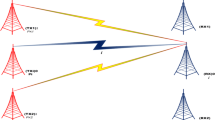Abstract
This paper determines the coverage reduction of the Wideband CDMA (WCDMA) downlink in the case of interference, due to adjacent narrowband system. The coverage reduction has been evaluated in terms of blocking area around the interfering base station. The analysis takes into account different interference mechanisms and their individual effects to the coverage. The interference mechanisms which have been considered here are the out-of-band emissions of the base station transmitter, the adjacent channel interference due to non-ideal sideband filtering, the intermodulation and the crossmodulation. The coverage effects in realistic network environment have been computed by using accurate ray-tracing propagation models designed for the path loss calculation in the urban environment. In the numerical examples, the effect of GSM interference has been demonstrated, but the method can be utilized with other narrowband systems as well. The results can be utilized in radio system design, radio network planning (RNP) and the frequency allocation of the WCDMA systems.
Similar content being viewed by others
References
K. Hamied and G. Labedz, “AMPS Cell Transmitter Interference to CDMA Mobile Receiver”, Proceedings of Vehicular Technology Conference, Vol. 3, pp. 1467–1471, 1996.
D. Kwon, H. Hong and S. Kang, “CDMA Mobile Station Intermodulation Interference Induced by AMPS Competitor Base Station”, Proceedings of IEEE 4th International Symposium on Spread Spectrum Techniques and Applications, Vol. 1, pp. 380–384, 1996.
S.C. Yang, CDMA RF System Engineering, Artech House, 1998.
European Telecommunications Standards Institute (ETSI), GSM 05.05, http://www.etsi.org.
3rd Generation Partnership Project (3GPP), Technical Specification Group (TSG), UTRA FDD, Radio Requirements: TS 25.101 and TS 25.104.
J.S. Lee and L.E. Miller, CDMA Systems Engneering Handbook, Artech House Publishers, 1998.
J. Laiho, A. Wacker and T. Novosad (eds), Radio Network Planning and Optimization for UMTS, Wiley & Sons, 2001.
K. Heiska and A. Kangas, “Microcell Propagation Model for Network Planning”, IEEE. Proc. of PIMRC '96, Taiwan, Oct. 1996, pp. 148–152.
B. Ko, D. Cheon, S. Kim, J. Ko, J. Kim and B. Park, “A Nightmare for CDMA RF Receiver: The Cross Modulation”, in AP-ASIC '99, 1999, pp. 400–402.
V. Aparin, B. Butler and P. Draxler, “Cross-Modulation Distortion in CDMA receivers”, in Proceedings of IEEE MTTS, 2000, pp. 1953–1956.
G. Wölfle, R. Hoppe and F.M. Landstorfer, “A Fast and Enhanced Ray Optical Propagation Model for Indoor and Urban Scenarios, Based on an Intelligent Preprocessing of the Database”, in Proceedings of the 10th PIMRC 1999, Osaka, Japan, Sept. 1999, F5-3.
Author information
Authors and Affiliations
Rights and permissions
About this article
Cite this article
Heiska, K., Posti, H., Muszynski, P. et al. WCDMA Downlink Coverage Reduction Due to Adjacent Channel Interference. Wireless Personal Communications 23, 217–242 (2002). https://doi.org/10.1023/A:1021184519770
Issue Date:
DOI: https://doi.org/10.1023/A:1021184519770




